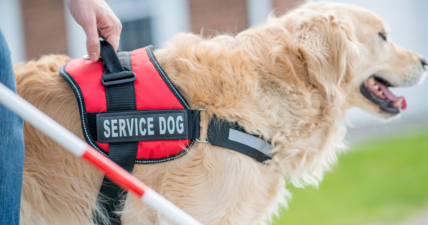How This Service Dog Transformed a 12-Year-Old Girl’s Life After Paralysis
Emma was just eight years old when a car accident left her paralyzed from the waist down. Now a wheelchair user, Emma and her mom have worked hard to find new ways to do everything she loves like horseback riding and working in the garden. Being paralyzed hasn’t stopped Emma, but sometimes she needs a little extra help to do some tasks.
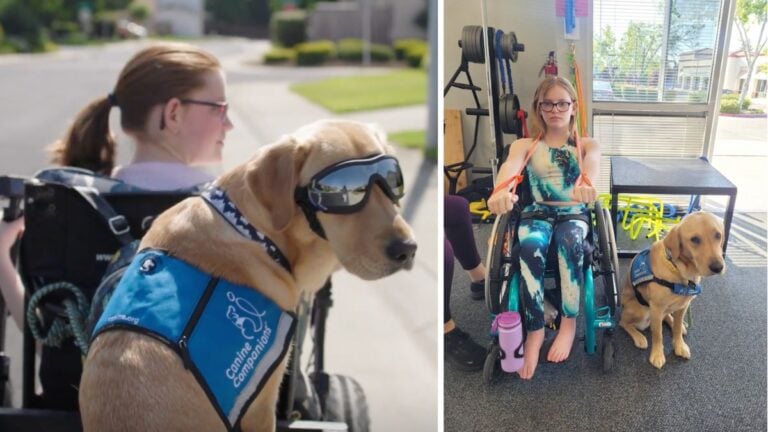
Emma is now twelve and just got matched with her first service dog—a beautiful yellow Labrador Retriever named Marcia. Love at first sight, Emma and Marcia have already built a close bond, less than a year after starting their journey together. “I can’t really imagine my life without her,” says Emma.
Marcia helps Emma do things more independently by helping her to open and close doors, carrying her garden basket for her, and accompanying her to school and extracurriculars. Marcia has gone to swimming lessons, horseback riding lessons, and even band practice!
One of the most valuable tasks Marcia is trained to do for Emma is “find mom.” If Emma needs help or is having an emergency, Marcia will run right to her mom, alert her, and guide her back to Emma’s side. Marcia keeps Emma safe, helps her live life to the fullest, and has become one of her very best friends.
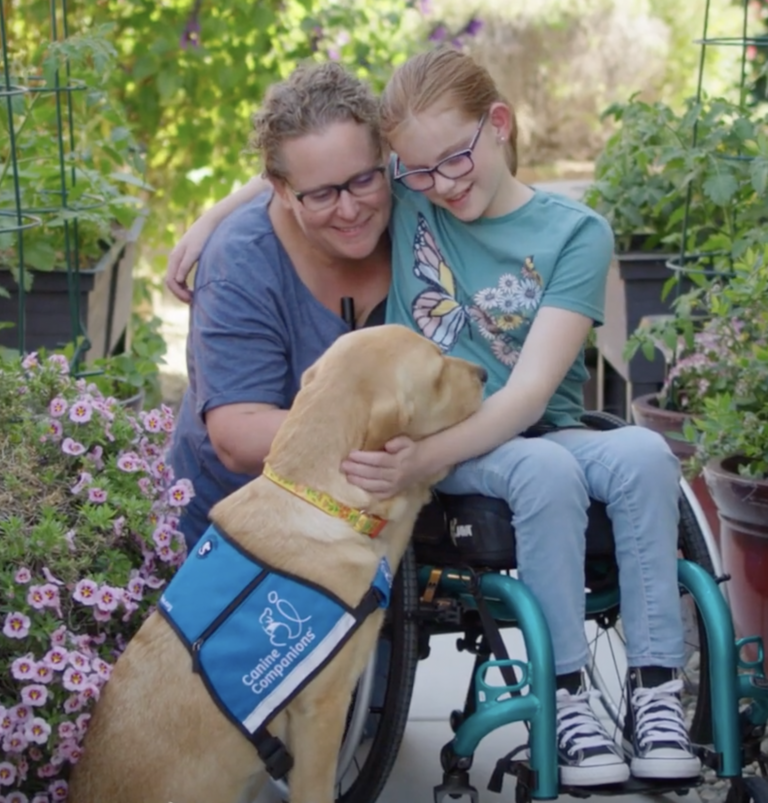
So how can other people with disabilities get a service dog? What types of service dogs are available, and are they a good option for every person with a disability? Let’s learn some of the basics of what service dogs are, what they do, and how to get a free service dog if you qualify.
What Is A Service Dog?
Service dogs are dogs that have specifically been trained to do work or perform tasks for people with disabilities. Service dog training programs begin working with dogs when they are around 6–12 months of age. Before a dog can be trained for a specific task, they first need to pass temperament and personality tests. Service dogs then undergo basic obedience training and are trained to perform tasks for a specific type of disability and/or their future handler’s specific needs.
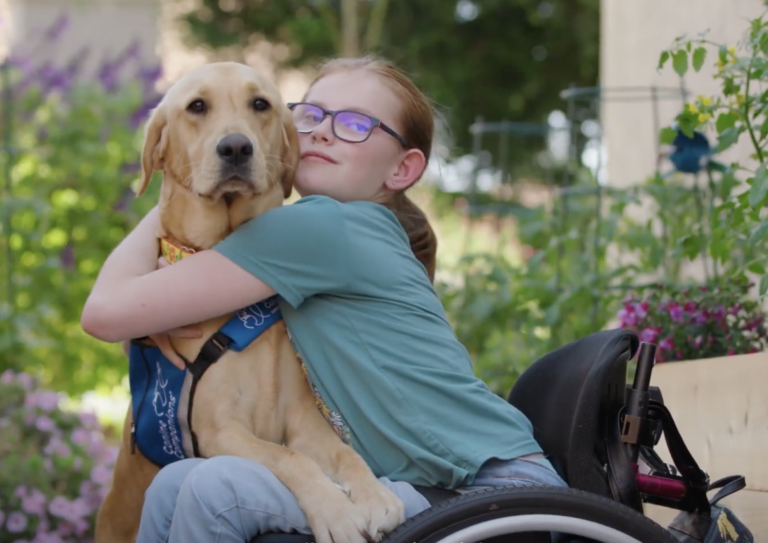
Some service dog training programs do the majority of their training before the dog is matched with a handler, then work with them to customize the dog’s skills. Other programs prioritize matching handler to dog much earlier in the process and involve service dog handlers in all components of how they train the dog. “Service dog handler” is the proper nomenclature for an individual with a disability who works with a service dog.
Service dog training varies slightly depending on what kind of service dog they will be. For example, psychiatric service dog training can look very different from mobility assistance dogs. Typically, service dogs are trained for one specific disability, but the rare service dog can perform multiple types of tasks.
Types of Service Dogs
Not a one-size-fits-all solution, the specificity of service dog training is key to matching the right dog with the right person. Service dog trainers not only teach dogs to perform tasks but also have to select puppies that have the right traits for specific types of service dog jobs. Here are the most common types of service dogs and what they do.
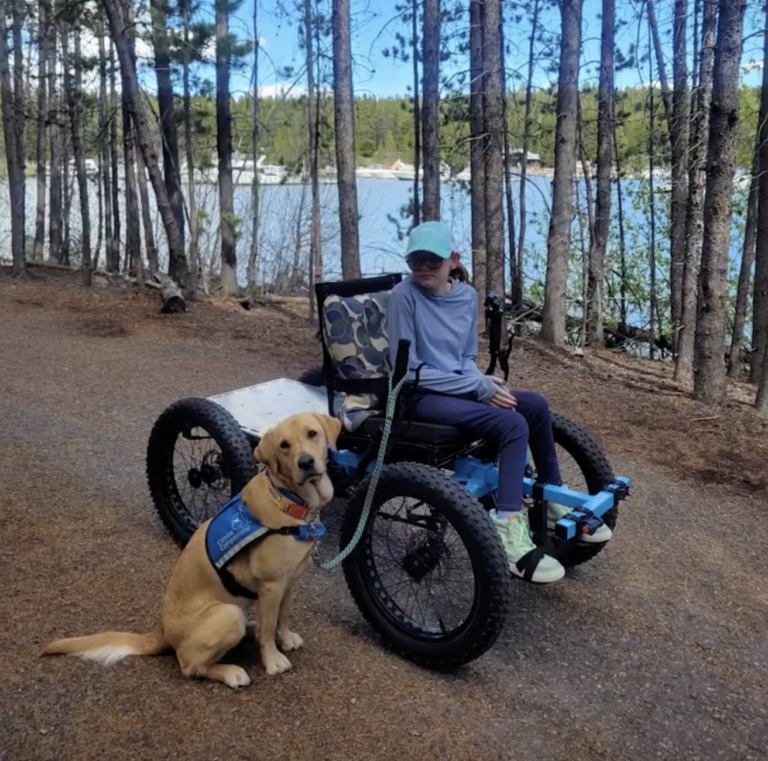
Allergy Detection Dogs
Allergy detection dogs detect allergens in food, drinks, and physical environments. For people with life-threatening allergies, eating even the smallest amount of an allergen—or even breathing it in—can cause anaphylaxis. Allergy detection dogs smell their handlers’ food and drinks before they eat to make sure their food is safe, help them grocery shop and select products, and alert them to unexpected allergen contamination.
Some allergy detection dogs are also trained to retrieve medications and alert other people if their handler has a medical emergency.
Autism Service Dogs
Autism service dogs provide psychological and physical support to autistic people. Autism service dogs can be trained to interrupt or redirect self-injurious behaviors, provide emotional support, perform crowd control (often by circling the individual to keep strangers out of their handler’s bubble), provide sensory input, and more. Autism service dogs can even help their handlers gain confidence and socialize with more freedom.
“What’s truly astonishing is how much more Laina communicates since [her service dog] Reva arrived,” says the mother of Laina, a young autistic service dog handler. “It’s as if Reva has unlocked a part of her voice that was hidden away, waiting for the right companion to bring it out…Reva is not just a companion; she is a lifeline, a source of strength, and a reason for Laina to embrace each new day with hope.”
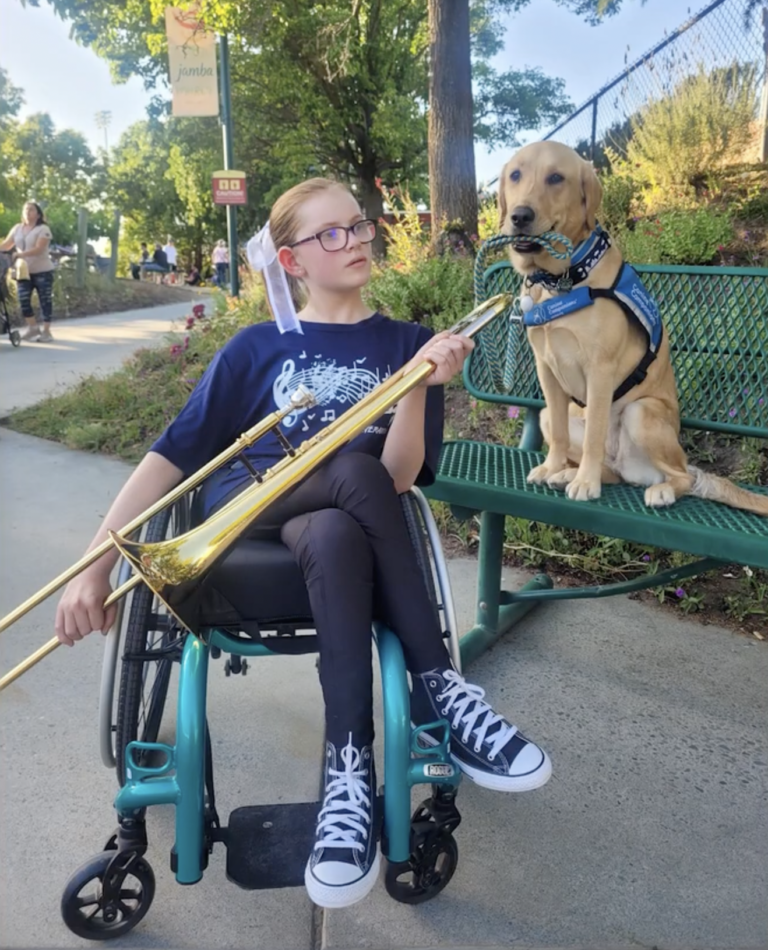
Learn more about how to get a free service dog for autism from Dogs For Better Lives, or a service dog training program in your area.
Diabetic Alert & Response Dogs
Did you know a dog can be trained to smell the subtle chemical changes human bodies go through? Diabetic alert dogs are trained to detect and alert to both high and low blood sugar levels in their handlers.
“Similar to dog dogs trained to detect contraband, [diabetes alert dogs] are conditioned to respond with specific alerting behaviors when their owners’ blood sugar falls outside a target range,” says a study on the efficacy of diabetes alert dogs. “This prompts the patient to test their blood glucose level, and to take appropriate action (e.g. insulin administration or eating) to retain appropriate glucose levels.” There are also diabetes response dogs that are trained to retrieve medication or food for their owners in case of abnormal blood sugar levels.
You can learn how to get a diabetic service dog for free through the National Institute of Canine Service and Training.
Guide Dogs
Guide dogs help blind and visually impaired people navigate the world. Guide dogs can lead their handlers through obstacles or to specific destinations, retrieve items for their handlers, navigate opening and closing doors, alert to visual queues, and more.
Learn more about guide dogs and how to get a dog as a service dog for free if you are blind or visually impaired by visiting the Guide Dog Foundation online.
Hearing Dogs
Hearing dogs alert their deaf and hard-of-hearing handlers to important sounds like sirens, alarms, doorbells, babies crying, and more. Hearing dogs can alert both to help their handlers perform daily tasks and to keep their handlers safe in an emergency.
Learn how to get a trained service dog for hearing impairment at no cost to you through Paragon Service Dogs
Mobility Assistance Dogs
Mobility assistance dogs perform a variety of tasks for their humans including providing physical support when standing or moving, retrieving items, opening doors, pushing buttons, etc. Assigned to people with disabilities that limit their mobility, these dogs offer their handlers more independence, security, and safety.
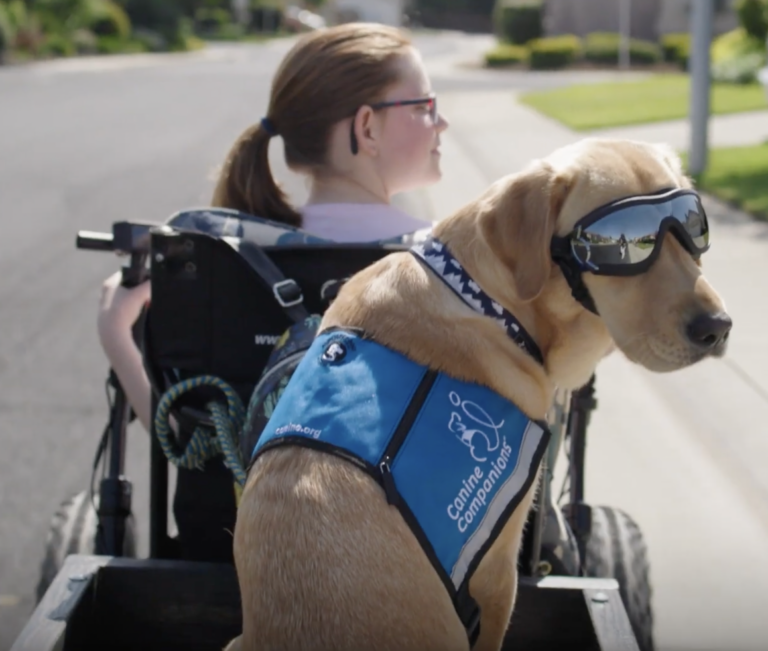
Psychiatric Service Dogs
Psychiatric service dogs—sometimes colloquially called mental illness service dogs—are trained to perform physical tasks and offer emotional support. Psychiatric service dogs can be trained for handlers with a wide range of mental illnesses including anxiety, depression, PTSD, schizophrenia, agoraphobia, and more. If you search “how to get a service dog for anxiety” you might see results for “how to get a service dog for PTSD” because they are considered the same “type” of service dog.
Some physical tasks you can train a dog to do for psychiatric assistance include:
- Panic attack detection
- Deep pressure therapy
- Medication retrieval
- Crowd control
- Self-injurious behavior redirection
Visit Paws 4 People to learn how to get a psychiatric service dog for free, or to learn more about how to get a mental health service dog.
Seizure Alert Dogs
Seizure alert dogs can smell the chemical changes that occur in their handlers’ bodies before a seizure and alert them to either find a safe place or administer medication. Many seizure alert dogs also provide deep pressure therapy to keep their humans safe during a seizure, can retrieve medication, and are trained to find help in an emergency.
Learn how to get a free service dog for epilepsy or how to get a free service dog for seizures by visiting Paws 4 People online.
How To Get A Service Dog For Free
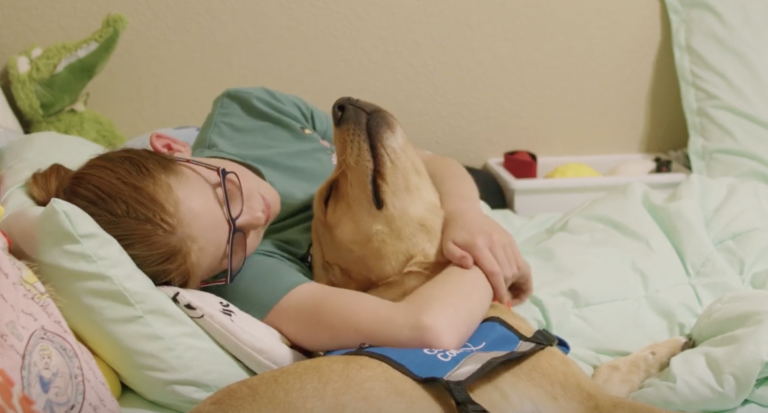
Did you know that most service dogs are provided to their handlers for free? You can find out how to get a service dog for depression and anxiety, how to get a service dog for seizures, or any other kind of service dog through Assistance Dog International’s list of accredited service dog training programs.
The application process for a service dog can change depending on the training program you choose and what your specific needs are. In almost all cases, you will need to provide documentation from physicians or licensed mental health professionals describing your disability and needs. You will also need to work closely with the team you choose to match with the right dog.
Some programs allow handlers to work with dogs they already have, assuming they pass temperament and behavioral assessments.
Service Dog FAQ
Get quick answers to your pressing questions about life with a service dog!
Can I fly on an airplane with my service dog?
Yes. Here’s a summary of what the Air Carrier Access Act says about service dogs on airplanes: “Airlines are required to allow service animals and emotional support animals traveling with individuals with a disability to sit with them in the cabin of the airplane. If requested before the flight’s departure, the traveler must be given a bulkhead seat.”
Can I go into a store with my service dog?
Yes. The ADA requires restaurants, stores, hotels, etc. in the United States to allow service dogs inside, even if they do not allow pets.
Does my service dog need to be on a leash?
Sometimes. According to the ADA, service animals “must be harnessed, leashed, or tethered while in public places unless these devices interfere with the service animal’s work or the person’s disability prevents the use of these devices. In that case, the person must use voice, signal, or other effective means to maintain control of the animal.”
Service animals always need to be under the “control” of their handler, but that doesn’t necessarily mean on-leash.
Do I need to carry documentation to prove my service dog is real?
No! There are no documents to prove that service dogs are real. Some service dog training programs will hand out “service dog certifications” to prove that they have undergone training, but these documents are not necessary, official, or legally binding. Employees of public establishments may not request documentation or licensure from service dog handlers, and handlers are not required to carry any kind of certification to exercise their rights.
What is the difference between a service dog and a therapy animal?
Service dogs must be dogs and are trained to do specific tasks for disabled people.
Therapy animals can be dogs, cats, or any other variety of animals, and are not task-trained. Therapy dogs only provide emotional comfort for their humans or people they visit and do not have the same legal protections as service dogs.
What is the difference between a service dog and an emotional support animal?
Unlike service dogs, emotional support animals (ESAs) do not need to be dogs and do not need any training. Emotional support animals are approved by therapists and mental health professionals and offer emotional support to their humans/owners. ESAs do not have the same rights as service dogs and are treated the same as pets in public spaces. However, ESAs are protected from housing restrictions like breed bans, size limits, and pet-free rentals.



